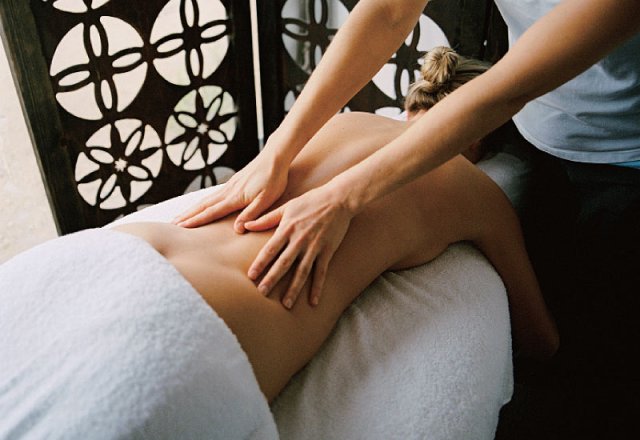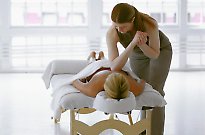
Aboriginal healing for tense shoulders and tired souls

The ancient Aboriginal Kodo massage does more than just relieve tired and aching muscles.
It is like a massage for the soul, releasing negative energies and enhancing positive energy flow as well as releasing niggling knots and muscular tension, as Liz Nowosad discovers.
WHAT IS IT?
Kodo means Melody and melodic is a perfect way to describe this rhythmic massage. Inspired by traditional Australian Aboriginal techniques, the massage is intended to tone and re-align energy flow, enhancing mind and body balance and wellness. A combination of pressure point manipulation, gentle stretching and spiralling movements, ground and uplift to balance the body's energies. Prior to the treatment, the client selects one of three LI’TYA native aromatic oil blends – selected to address individual needs – whether they be to rejuvenate, reharmonise or detoxify.
I had the massage at Peninsula Hot Springs, Victoria – just over an hour's drive from Melbourne. Unlike many hot springs where the water is artificially heated, at Peninsula Hot Springs the water enters the pool pools at 38 to 43 degrees C – the perfect temperature to relax and soak away stiffness and sores. The water contains a range of naturally occurring minerals including sulphur, calcium, magnesium and potassium, to mention just a few. According to the Japanese Health Authority, the therapeutic benefits of bathing in this type of thermal mineral spring are said to include the alleviation of neuralgia, bruising, breaks, articular rheumatism, stiffness of the shoulders, skin diseases, recovery from fatigue, infertility and muscular complaints. The heat in the water induces blood flow and sweating, both releasing toxins in the system and assisting the body to heal itself. The higher the temperature, the faster the flow.
THE TECHNIQUE
The Kodo massage uses LI’TYA products – whose natural ingredients are based on the beliefs and knowledge of indigenous Australians, and therapists are trained by Aboriginal elders in ancient techniques of indigenous healing massage. “It’s really quite a different massage,” claims my massage therapist. “It’s uncomplicated, but effective. When you’re taught massage you’re taught to massage towards the heart from the outside in, but in this principle it’s the other way around. All the negative energy is released.”
THE EXPERIENCE
As much as I love a good massage, sometimes I struggle to fully relax until near the end, by which point it’s all over too quickly! The great thing about having a massage at a natural hot spring however, is that your muscles are pretty loose and limber before you climb onto the massage bed.
After 20 minutes of pool hopping, it was time for my Kodo massage. The therapist led me into the massage room and asked me to take a seat. She produced three scented oils and a hand carved wooden Coolomon dish containing dried lemon myrtle leaves. Seated with my eyes closed, my therapist asked me to smell the three different scented oils. She told me that I would be instinctively attracted to the one that resonated most with my bodies needs at this time, whether the need be to rejuvenate, reharmonise or detoxify. I chose the Reharmonise Oil Blend, which is apparently good at relieving anxiety and stress and bringing overall balance. After choosing my oil, my therapist performed an Aboriginal smoking ceremony with the lemon myrtle leaves. This is performed before the treatment to bring your mind into the ‘here and now’ and to connect you to the therapist and ground your senses. The smell is quite unique, almost like a woody bonfire infused with lemon myrtle and moss.
I got onto the bed face down and the masseuse draped a warm fluffy towel over my bottom and lower body. She applied a generous amount of oil to my back and applied medium pressure, in large sweeping strokes. She focused on the knots around my shoulder blades for a few minutes before moving on to my arms, then legs and finally (after turning me onto my back) she moved onto my neck and head. As well as kneading the muscles of my limbs, she also performed gentle stretches to loosen the joints.
By the end of the one-hour massage, I felt relaxed from head to toe. Unlike some types of massage that can leave you a little tense because of the anticipation of pain, the Kodo is pure relaxation. It is a massage that goes deep enough to alleviate muscle soreness and stiffness, yet not so deep that it is in any way uncomfortable. I also felt a definite sense of psychological release during the massage – my usual mind chatter uncharacteristically quiet.
WHO IS IT FOR?
“The Kodo massage is a treatment designed to suit everyone – even pregnant women can be accommodated,” says Karina Reyne, spokesperson for LI’TYA. “It is wonderful relief for stress and tension, leaving the recipient uplifted, more balanced and with a sense of improved wellbeing.”
ABOUT THE PRACTITIONER
Peninsula Hot Springs co-founder and director Charles Davidson is passionate about the healing benefits of the hot springs and of traditional healing practices like the Kodo massage. He set up the Peninsula Hot Springs and spa following an inspiring trip to the hot springs in the Japanese town of Kusatsu in 1992.
“It was about March and the winter snow was still on the ground and in the trees around the pools,” says David. “The sense of connection and blissful relaxation was amazing. I said to myself, ‘why don't we have this in Australia?’ We love the outdoors and we love relaxation and this was the best expression of the two I had and still have come across. Bathing as an art has been around as long as warm waters have flowed to the surface from deep under ground - that would be as long as man, water and the earth have been around. Tens of thousands of years - think of how long Aboriginals have been in Australia - the water has been there longer, and it was hot then like it is now.”
Next: Browse the A-Z of massage therapies and choose one to suit you.


